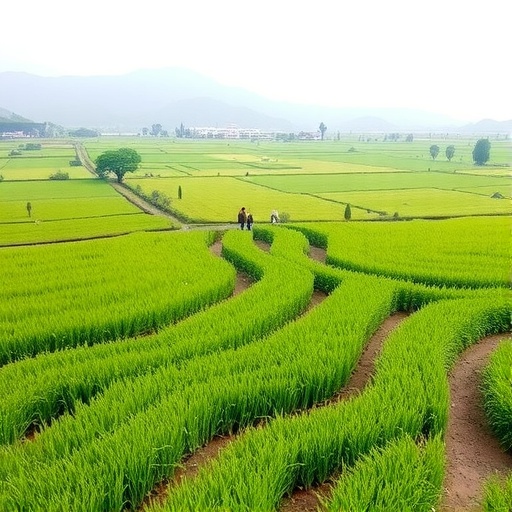In a groundbreaking study led by researchers Gong, Xu, Ji, and their team, the complex landscape of agricultural carbon emissions in Anhui province has been meticulously analyzed. The framework of their investigation encapsulates the spatial and temporal evolution of carbon emissions related to agriculture, shedding light on the intricate interplay of driving factors and the phenomenon of decoupling effects. This comprehensive research endeavors not only to quantify emissions but also to elucidate the mechanisms underlying carbon release in one of China’s key agricultural regions.
The study’s foundation rests on a robust longitudinal analysis that explores how agricultural practices contribute to carbon emissions over time. By examining historical data, the researchers reveal a clear trend of increasing emissions correlated with industrial activities and agricultural intensification. They highlight how rapid urbanization and population growth in Anhui have significantly impacted not only farmland use but also the carbon footprint associated with agricultural practices. This temporal evaluation provides essential insights into the consequences of policy changes and economic developments over the years.
A pivotal aspect of the analysis is the identification of driving factors behind the fluctuating emissions levels. The researchers conducted an in-depth investigation that includes both socio-economic indicators and environmental variables. Key factors such as fertilizer application rates, livestock production levels, and land-use changes were scrutinized to assess their direct correlation with carbon emissions. The findings suggest that while certain trends indicate potential for emissions reduction, the overall increase in agricultural productivity often leads to heightened carbon outputs.
Simultaneously, the study delves into the concept of decoupling effects, which pertains to the separation of economic growth from carbon emissions production. In this context, the authors meticulously analyze instances where economic development occurs without a corresponding rise in emissions. This decoupling is crucial for establishing sustainable agricultural practices, and understanding it may pave the way for developing agricultural models that prioritize both productivity and environmental responsibility.
To reinforce their results, the researchers employed advanced statistical methods and models to correlate various predictors of agricultural carbon emissions. By using cutting-edge analytical tools, they were able to create a detailed representation of emissions patterns across different regions in Anhui. This spatial analysis reveals significant geographical disparities, with certain areas exhibiting higher emissions due to specific agricultural practices and types of crops grown. This geographical perspective is vital for policymakers aiming to target strategies for emissions reduction effectively.
Moreover, the researchers underscore the role of government policies and incentives in shaping agricultural practices and emissions outcomes. They point out that the implementation of eco-friendly farming techniques, precision agriculture, and carbon trading mechanisms could significantly influence the reduction of agricultural carbon footprints. This highlights the urgent need for integrated policy frameworks that encourage environmentally friendly practices while also fostering economic growth in the agricultural sector.
Furthermore, the research touches on the role of technology and innovation in driving sustainable agricultural practices. Advances in agri-tech, such as the use of drones for crop monitoring, AI-based predictions for crop yields, and improvements in soil health management practices, play a crucial role in mitigating emissions. The findings emphasize that leveraging technology could be instrumental in achieving both higher productivity and lower emissions, ultimately supporting the United Nations Sustainable Development Goals.
In addition to providing scientific rigor, the study also articulates the intrinsic relationship between agricultural carbon emissions and climate change. The authors express concern over the long-term implications of sustained agricultural emissions on global warming. They advocate for the urgent need to prioritize carbon-neutral practices in agriculture, foreseeing benefits not only for local ecosystems but also for global climate stabilization efforts.
Community engagement and education form another critical aspect addressed in the research. The authors argue that educating farmers and local communities about sustainable agricultural practices enhances the overall effectiveness of policies designed to reduce emissions. Collaboration between researchers, farmers, and policymakers is essential in creating a sustainable ecosystem that is responsive to the challenges posed by climate change, ensuring long-term viability for the agriculture sector in Anhui and beyond.
Additionally, the implications of this research extend to international dialogues on climate change mitigation strategies. As regions across the globe grapple with the dual challenges of food security and carbon emissions, the insights garnered from Anhui’s experience can serve as a valuable case study. This research illustrates the nuanced challenges and opportunities faced by agricultural systems worldwide, suggesting pathways for harmonizing agricultural development with sustainability goals.
In conclusion, the analysis of agricultural carbon emissions in Anhui represents a significant contribution to the understanding of the carbon dynamics in agricultural systems. The multifaceted approach utilized by Gong, Xu, Ji, and their colleagues offers a well-rounded perspective on the critical interplay between economic factors, agricultural practices, and environmental outcomes. The research not only advances the scientific discourse on carbon emissions but also advocates for actionable solutions that honor both agricultural productivity and ecological integrity, thereby paving the way for a sustainable future.
This timely discourse stresses the importance of proactive measures and sustainable practices that align with global efforts to combat climate change. As the pressures of climate change intensify, the findings of this research hold significant promise for informing policies that mitigate agricultural carbon emissions while fostering resilient agricultural systems capable of supporting future generations.
With this comprehensive examination of the spatial and temporal evolution, alongside driving factors and decoupling effects, the work will undoubtedly serve as a catalyst for ongoing research and discussion in the arena of sustainable agriculture and climate science.
Subject of Research: Agricultural Carbon Emissions in Anhui
Article Title: Analysis of spatial and temporal evolution, driving factors and decoupling effects of agricultural carbon emissions in Anhui.
Article References:
Gong, S., Xu, H., Ji, Y. et al. Analysis of spatial and temporal evolution, driving factors and decoupling effects of agricultural carbon emissions in Anhui.
Discov Sustain 6, 950 (2025). https://doi.org/10.1007/s43621-025-01910-6
Image Credits: AI Generated
DOI:
Keywords: Agricultural carbon emissions, Anhui, spatial analysis, temporal evolution, driving factors, decoupling effects, sustainable agriculture, climate change, policy frameworks.




